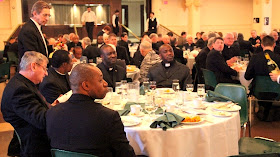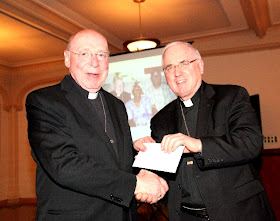Basilique-cathédrale Notre Dame Cathedral Basilica – Ottawa, Ontario
The Chrism Mass, la Messe chrismale – le 26 mars, March 26, 2013
« L’ESPRIT DU SEIGNEUR EST SUR MOI PARCE QUE LE SEIGNEUR M’A CONSACRÉ PAR L’ONCTION » (Is. 61, 1)
[Textes : Isaïe 61, 1-3, 6, 8-9; Psaume 88 (89); Apocalypse 1, 5-8; Luc 4, 16-21]
Mes chers frères prêtres, en particulier vous qui célébrez un anniversaire spécial cette année, mes chères sœurs et chers frères dans le Christ /My dear brother priests—especially you who are celebrating a special anniversary this year—and my dear sisters and brothers in Christ:
“THE SPIRIT OF THE LORD GOD IS UPON ME, BECAUSE THE LORD HAS ANOINTED ME” (IS 61.1)
Today in the Gospel, we hear Jesus quote this passage from the prophet Isaiah. He applies its true meaning to himself. It foretold his divine mission, in his ministry, suffering, passion and death.
Tonight, the priests affirm again the promises they made when they were consecrated priests in union with our one High Priest, Jesus Christ. They serve in collaboration with the apostolic mission of the bishop. They carry on in the parish, the hospital, the jail, the long-term care facility, the same mission of Jesus Christ we heard about in the First Reading and the Gospel.
Les prêtres ‘’portent la Bonne Nouvelle aux pauvres, annoncent aux prisonniers qu’ils sont libres, aux aveugles qu’ils verront la lumière et aux opprimés la libération ‘’ (Luc 4, 18-19). Les personnes qui vivent en captivité à cause de leurs péchés sont pardonnées. Les personnes qui ne peuvent percevoir la présence de Dieu ressentent son amour. Aux personnes qui connaissent le désespoir, Jésus accorde sa miséricorde. Jésus Christ apporte à tous un espoir nouveau.
Le ministère du prêtre rend actuel la grâce qui sauve et qui transforme, la grâce que Jésus est venu apporter au monde. Cette force salvatrice nous est donnée par la Parole de Dieu et les sacrements de l’Église. Elle permet à chacun, chacune, des membres du peuple de Dieu de trouver les façons et la force de vivre en vrais disciples du Christ, d’en être ses témoins, de se mettre à son service.
L’Église utilise les huiles que nous consacrons ce soir pour préparer les catéchumènes pour leur baptême, oindre les nouveaux-baptisés, sceller les candidats à la Confirmation, consacrer les mains des prêtres et les évêques à leur ordination, pour guérir les malades et leurs apporter réconfort. Les huiles nous aident à révéler au monde l’amour de Dieu, Lui, le Tout-Puissant, qui continue de prendre soin de son peuple.
The Catechism of the Catholic Church reminds us that “anointing, in Biblical and other ancient symbolism, is rich in meaning: oil is a sign of abundance and joy; it cleanses (anointing before and after a bath) and limbers (the anointing of athletes and wrestlers); oil is a sign of healing, since it is soothing to bruises and wounds; and it makes radiant with beauty, health, and strength.” (CCC, n. 1293)
These three sacred oils that the bishop consecrates equip Christians for a life of discipleship: “the pre-baptismal anointing with the oil of catechumens signifies cleansing and strengthening; the anointing of the sick expresses healing and comfort. The post-baptismal anointing with sacred chrism in Confirmation and ordination is the sign of consecration. By Confirmation, Christians, that is, those who are anointed, share more completely in the mission of Jesus Christ and the fullness of the Holy Spirit with which he is filled, so that their lives may give off “the aroma of Christ” (CCC, n. 1294).


Marcher sur le chemin du Seigneur présente toujours un grand défi, peut-être aujourd’hui plus que jamais. À peine quelques jours après l’élection du pape François, certaines personnes avaient déjà commencé à le trouver trop ouvert aux changements, tandis que d’autres disaient qu’il n’apporterait vraiment rien de neuf. D’habitude, cela est un bon signe. Il faut savoir demeurer fidèle aux enseignements de l’Évangile du Christ tout en se donnant la liberté de lire les signes des temps.
Le bon disciple du Christ accepte de faire des sacrifices et d’autodiscipline. Il est fidèle à la pratique des sacrements – surtout les sacrements de la Réconciliation – s’adonne à la prière, lit les Écritures Saintes et cherche à suivre la volonté de Dieu.
Dans la première homélie qu’il a prononcé après son élection, le pape François rappela aux cardinaux réunis dans la Chapelle Sixtine que la Croix demeure au centre de toute vie chrétienne authentique : ‘‘Quand nous cheminons sans la Croix, quand nous édifions sans la Croix et quand nous confessons un Christ sans la Croix nous sommes mondains : nous sommes des prêtres, des évêques, des cardinaux, des papes, mais pas des disciples du Seigneur.’’
St. Paul reminds us that, as Christians, we are proud of what we believe. But, he cautions us, “May I never boast of anything except the cross of our Lord Jesus Christ, by which the world has been crucified to me, and I to the world” (Galatians 6.14)
The holy oils we use in the sacraments of baptism, confirmation, holy orders and the sacrament of the sick are beautiful, powerful, tangible outward signs revealing the action of the Holy Spirit. He cleanses, consecrates, and equips us to carry our cross with courage and conviction as Christian witnesses.
Our God-given mission in the New Evangelization is to proclaim the Gospel to a world hungry for Goodness, Beauty and Truth. Our world is hungry and thirsty for God. He alone can satisfy our deepest longings for love and meaning–the Good News of Jesus Christ.
 |
| Fr. Peter Monty, S.J. signs for the hearing-impaired |
Le texte d’Isaïe et l’évangile de Luc nous parlent de la mission du Christ. L’Église, Corps du Christ, continue de porter cette mission au monde en notre temps. Elle accomplie cette mission à travers le ministère apostolique de l’évêque. Elle le fait à travers le ministère des prêtres rassemblés autour de lui et des baptisés qui collaborent chacun à leur manière à cette mission. Elle le fait au moyen des sacrements et de la proclamation de la Parole, cette Parole qui est ‘‘vivante et énergique et plus coupante qu'une épée à deux tranchants ’’ (Hébreux 4, 12). Elle le fait à travers le ministère de notre pape François.
Comme notre Bon Berger, notre Sauveur, notre ami et notre Seigneur, Jésus-Christ, nous pouvons dire, nous ses disciples, que nous aussi nous avons été consacrés pour ‘’porter la Bonne Nouvelle aux pauvres, annoncer aux prisonniers qu’ils sont libres, aux aveugles qu’ils verront la lumière et aux opprimés la libération ‘’ (Luc 4, 18-19).
Photos: Robert Du Broy, Paul Lauzon, Fr. Jonathan Blake
* * * * * *
HOLY THURSDAY:
INSTITUTION OF THE EUCHARIST,
OF THE PRIESTHOOD,
& THE CALL TO LOVE ONE ANOTHER
 |
| Jacopo Bassano, The Last Supper (1542) |
O God, who have called us to participate in this most sacred Supper, in which your Only Begotten Son, when about to hand himself over to death, entrusted to the Church a sacrifice new for all eternity, the banquet of his love, grant, we pray, that we may draw from so great a mystery, the fullness of charity and of life. Through our Lord Jesus Christ, your Son, who lives and reigns with you in the unity of the Holy Spirit, one God, for ever and ever.
* * * * * *
Ne t’étends pas sur cette croix,
Oh ! Jésus,
Ne t’étends pas sur cette croix
Jusqu’à mourir !
Si je ne m’étends pas sur cette croix
Comme un oiseau,
Qui donc vous gardera contre l’Enfer
Où vous alliez ?
Je m’étendrai sur cette croix
Comme un oiseau.






















































